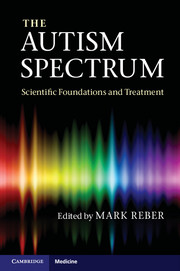Book contents
- Frontmatter
- Contents
- List of Abbreviations
- List of Contributors
- Preface
- Section 1 What We Know about Autism and How We Know It
- Section 2 Assessing and Treating Children with Autism Spectrum Disorders
- Chapter 7 Autism screening and diagnostic evaluation
- Chapter 8 Educational treatments for children with ASDs
- Chapter 9 Habilitative treatments for children with ASDs
- Chapter 10 Behavioral treatments for children with ASDs
- Chapter 11 Medication and nutritional treatments for children with ASDs
- Section 3 Assessing and Treating Adults with Autism Spectrum Disorders
- Index
- Plate Section
- References
Chapter 9 - Habilitative treatments for children with ASDs
speech and occupational therapy, assistive technology
from Section 2 - Assessing and Treating Children with Autism Spectrum Disorders
Published online by Cambridge University Press: 05 November 2012
- Frontmatter
- Contents
- List of Abbreviations
- List of Contributors
- Preface
- Section 1 What We Know about Autism and How We Know It
- Section 2 Assessing and Treating Children with Autism Spectrum Disorders
- Chapter 7 Autism screening and diagnostic evaluation
- Chapter 8 Educational treatments for children with ASDs
- Chapter 9 Habilitative treatments for children with ASDs
- Chapter 10 Behavioral treatments for children with ASDs
- Chapter 11 Medication and nutritional treatments for children with ASDs
- Section 3 Assessing and Treating Adults with Autism Spectrum Disorders
- Index
- Plate Section
- References
Summary
In addition to social and communication impairment and restricted, repetitive behaviors, children and adults with autism may experience other symptoms that contribute to disability. These concomitant symptoms can include motor and motor planning deficits, sensory deficits such as impaired hearing and vision, sensory processing and modulating disorders, and specific learning disabilities. These impairments can limit an individual’s ability to function and participate in home, leisure, school, and work activities. In early intervention, preschool and school programs, children with ASDs are often referred to speech-language pathologists, occupational therapists, and other related service providers to remediate core and co-occurring symptoms. The present chapter will review some characteristics of core communication deficits and frequently accompanying motor and sensory deficits in autism. It will also describe interventions that are conducted by speech-language pathologists and occupational therapists in contexts of comprehensive and focused treatment programs, and address the use of assistive technology.
ASD characteristics affecting communication skills
Impairments in communication are a core deficit in individuals with autism spectrum disorders. These impairments affect a person’s ability to communicate in a variety of contexts and limit adaptive functioning. Speech and language impairments in ASDs may manifest in how an individual is able to form words and to understand and produce meaningful language. Many individuals with autism never develop the ability to speak, and a large number of those who do acquire speech do not use it in a meaningful way. Some studies have suggested that one-third (Bryson, 1996) to one-half (Lord and Paul, 1997) of children diagnosed with autism may fail to develop functional speech (Bosserler and Massaro, 2003). Even for those who do use language meaningfully, social skills and conversational skills can be areas of great difficulty, and communication milestones are often delayed.
- Type
- Chapter
- Information
- The Autism SpectrumScientific Foundations and Treatment, pp. 217 - 238Publisher: Cambridge University PressPrint publication year: 2012
References
- 5
- Cited by



